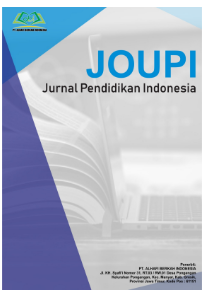Pengaruh Media Pembelajaran Teka-Teki Silang Terhadap Hasil Belajar Peserta Didik Kelas IV Sekolah Dasar
DOI:
https://doi.org/10.62007/joupi.v1i3.79Keywords:
Learning Outcomes, Crossword Puzzle Learning Media, InfluenceAbstract
This research is motivated by the existence of problems in the field regarding the low learning outcomes of students in conventional learning, lack of utilization of facilities, infrastructure, and learning media, especially crossword learning media. This study aims to determine the effect of crossword learning media on the learning outcomes of grade IV elementary school students. The method used in this research is a quantitative method of experimentation with a quasi experimental design type nonequivalent group design. Data was collected using observation, pretest and posttest techniques. By determining respondents as a sample of 20 students using purposive sampling type. The results showed that both the control class and the experimental class conducted learning in accordance with the stages of the learning media used. Because the two classes were given different treatments, the results obtained were different. There is a significant influence on student learning outcomes between learning using crossword puzzle learning media and conventional learning. This can be proven based on the acquisition of the Independent Sample T-test test results seen from Equal variances assumed at the Sig value. (2-tailed) which is 0.000 <0.005, it means that Ho is rejected and Ha is accepted. Through the effect size test, it can also be seen that there is a big influence in learning activities using crossword learning media on student learning outcomes of 4.09. With that, researchers can conclude that there is a significant effect of crossword learning media on the learning outcomes of fourth grade students of SDN Gekbrong 1 Cianjur Regency.
References
Abd Rahman, B. P., Munandar, S. A., Fitriani, A., Karlina, Y., & Yumriani, Y. (2022). Pengertian Pendidikan, Ilmu Pendidikan Dan Unsur-Unsur Pendidikan. Al-Urwatul Wutsqa: Kajian Pendidikan Islam, 2(1), 1-8.
Abraham, I., & Supriyati, Y. (2022). Desain kuasi eksperimen dalam pendidikan: Literatur review. Jurnal Ilmiah Mandala Education, 8(3).
Ayudia, A., Suryanto, E., & Waluyo, B. (2017). Analisis kesalahan penggunaan bahasa indonesia dalam laporan hasil observasi pada siswa smp. Basastra, 4(1), 34-49.
Azmi, M. P. (2019). Analisis pengembangan tes kemampuan analogi matematis pada materi segi empat. JURING (Journal for Research in Mathematics Learning), 2(2), 099-110.
Djollong, A. F. (2014). Tehnik Pelaksanaan Penelitian Kuantitatif. Istiqra: Jurnal Pendidikan Dan Pemikiran Islam, 2(1).
Erida, M. (2021). Uji Validitas Dan Uji Reliabilitas Instrumen Motivasi Pengidap HIV/AIDS. Jurnal Ilmiah Bina Edukasi, 1(1), 10-21.
Jogiyanto Hartono, M. (Ed.). (2018). Metoda Pengumpulan dan Teknik Analisis Data. Penerbit Andi.
Juliandi, A., Manurung, S., & Satriawan, B. (2018). Mengolah data penelitian bisnis dengan SPSS. Lembaga Penelitian dan Penulisan Ilmiah AQLI.
Nurhasanah, E. (2021). Pengaruh Media Pembelajaran Berbasis Flashcard Huruf Hijaiyah terhadap Hasil Belajar Iqro pada Santri The Gold Generation. Jurnal Inovasi, Evaluasi Dan Pengembangan Pembelajaran (JIEPP), 1(2), 60-68.
Nurrita, T. (2018). Pengembangan media pembelajaran untuk meningkatkan hasil belajar siswa. Jurnal misykat, 3(1), 171-187.
Saputra, A. B. (2018). Pengembangan Media Pembelajaran dilengkapi Teka-Teki Silang Berbasis Flash pada Materi Sistem Gerak Manusia Kelas Xi SMA/MA (Doctoral dissertation, UIN Raden Intan Lampung).
Situmorang, T. E., & Purba, D. (2020). Perancangan Aplikasi Pengujian Validitas dan Reliabilitas Instrumen Penelitian. KAKIFIKOM: Kumpulan Artikel Karya Ilmiah Fakultas Ilmu Komputer, 1(2), 54-58.
Sugiyono (2019). Metode Penelitian Kuantitatif, Kualitatif, dan R&D. Bandung: Alphabet.
Sugiyono. (2013). Metode Penelitian Pendidikan. Bandung: Alfabeta.
Wahyuliani, Y., Supriadi, U., & Anwar, S. (2016). Efektivitas penggunaan media pembelajaran flip book terhadap peningkatan hasil belajar siswa pada mata pelajaran PAI dan budi pekerti di SMA Negeri 4 Bandung. TARBAWY: Indonesian Journal of Islamic Education, 3(1), 22-36.







